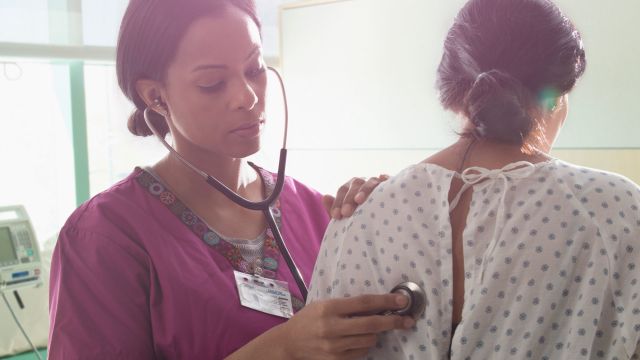Updated on March 28, 2024.
If you don't smoke, you might think you're not at risk for developing lung cancer, the leading cause of death from cancer in the United States. But studies show that the rate of nonsmokers with lung cancer is steadily rising.
A different kind of lung cancer
As fewer people are choosing to smoke, other factors are playing a larger role in the development of lung cancer. In fact, about 20 percent of people who are diagnosed with the disease are nonsmokers. And researchers have found that lung cancer in nonsmokers is usually different than the most common form found in smokers, called adenocarcinoma.
"There's definitely a molecular profile that's far different in someone who's a smoker versus a nonsmoker," says Robert M. Jotte, MD, PhD, a medical oncologist at Rocky Mountain Cancer Centers in Colorado. This means the cancer cells develop differently, which can affect treatment and the likelihood of other health complications.
For example, there’s some suggestion that cancers in nonsmokers may have more treatment options, which may help people who get these type of cancers live longer. Another big difference is that women seem more likely to get lung cancer if they’ve never smoked, compared to men.
What causes cancer in nonsmokers?
Smoking is still by far the leading contributor to lung cancer, but there are other factors that can increase risk in people who don't smoke. These include family history, exposure to secondhand smoke, previous cancer diagnoses, and air pollution or other environmental dangers.
Family history: If any direct relatives—such as your parents or siblings—have a history of lung cancer, you are at greater risk.
Secondhand smoke: Adults who don’t smoke have a 20 to 30 percent higher risk of developing lung cancer if they’re exposed to secondhand smoke, which is thought to be responsible for more than 7,300 lung cancer deaths in the U.S. each year, according to the Centers for Disease Control and Prevention. This is because the secondhand smoke contains many of the same cancer-causing substances that smokers inhale. And just like with smoking, your risk increases the more you’re exposed to secondhand smoke.
Previous cancer diagnoses: If you’ve had lung cancer in the past, you have a greater chance of developing it again. This is called a recurrence. There’s also an increased risk of a second cancer, which occurs when lung cancer develops as an effect of having a different type of cancer. This might stem from the cancer itself or as a long-term side effect of the treatment for the initial cancer. For example, radiotherapy (high-dose x-rays used to treat cancer) increases the risk for developing lung cancer later.
Environmental factors: Some substances found in the air and environment can increase your lung cancer risk. The most common is radon, a colorless, tasteless and odorless gas that can be found inside some homes. It’s the leading cause of nonsmoking lung cancer in the U.S. and is responsible for around 21,000 lung cancer deaths every year.
Living in an area with high air pollution, such as from heavy traffic or industrial activity, is another major risk factor. Working with certain dangerous substances like arsenic (a poison) and asbestos (a mineral that is fire resistant), especially without proper protective gear, can also greatly increase your risk. These kinds of substances are especially common in heavy industry jobs, like mining and construction.
How can you lower your risk of lung cancer?
Since lung cancer is typically unexpected in nonsmokers, it's usually found in later stages, which can make it harder to treat successfully. But these tips may help reduce your chances of developing the disease if you don’t smoke.
Test your home for radon
Radon is a naturally occurring carcinogen (cancer-causing substance) that can be found in home basements or crawl spaces. You can buy radon test kits at your local hardware store or online from the National Radon Program to confirm that your home is safe. Some local or county health departments or state radon programs may also provide free radon test kits.
Dr. Jotte notes that while radon testing is recommended, he advises not being overly concerned about it, relative to other risks. "Someone would have to spend a pretty high proportion of hours in the day in an enclosed environment to really get exposure levels implicated in lung cancer," he says.
Avoid secondhand smoke
If a loved one smokes, encourage them to quit. Not only will it benefit their health, but it will lower your odds of getting lung cancer, too. For information about tobacco cessation and whether your insurance may help cover costs, speak with your healthcare provider (HCP).
Avoid carcinogens
Some people may be exposed to cancer-causing carcinogens such as asbestos and other harsh pollutants as part of their job. Make sure your employer is following guidelines from the Occupational Safety and Health Administration (OSHA) and wear appropriate gear, like face masks, as much as possible to limit inhalation.
See if screening is right for you
If you're concerned about your lungs, you may want to look into getting screened for lung cancer. But many insurance companies cover these tests only for people with a history of smoking a certain amount and who are over 50 years old. Ask your HCP if it makes sense for you.
Talk with your HCP
If anyone in your family has had lung cancer, tell your HCP so they can look for early signs of lung cancer in you. "Even if those family members with lung cancer were smokers, I think that needs to be on your radar," Jotte says.
And be sure to discuss any odd—and not-so-odd—symptoms.
"A persistent cough that doesn't go away is not something that should be ignored," Jotte says. "A lot of the symptoms that can indicate an underlying problem like lung cancer are actually very common symptoms that all of us get at some point in our lifetimes."
Having a cough, having a slight pain in the chest, and feeling a little bit short of breath are common problems, he says, but those may also be the symptoms of lung cancer.
If you’re coughing blood, see an HCP promptly, especially if it occurs along with weight loss, loss of appetite, or shortness of breath.
Jotte says it's important to remember that even though the rate of nonsmokers getting lung cancer is increasing, most healthy nonsmokers don't get lung cancer.







